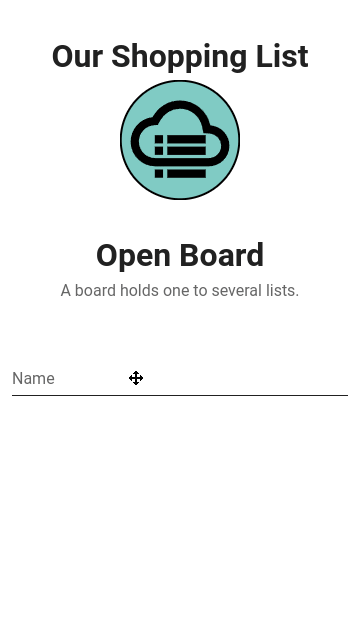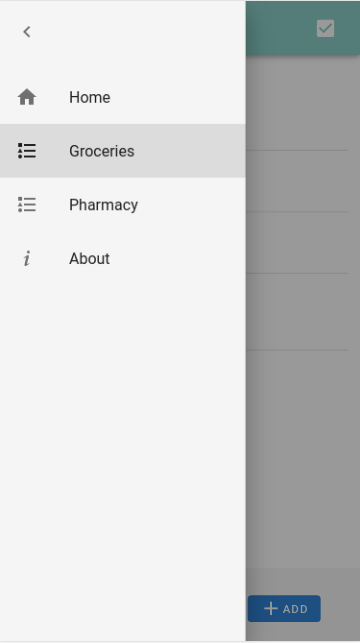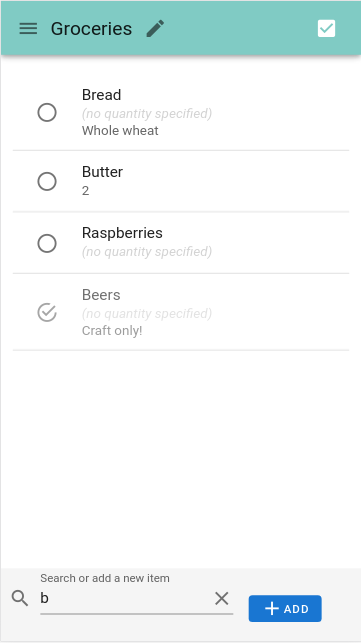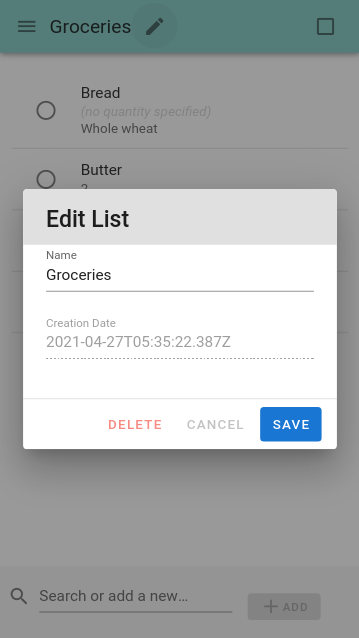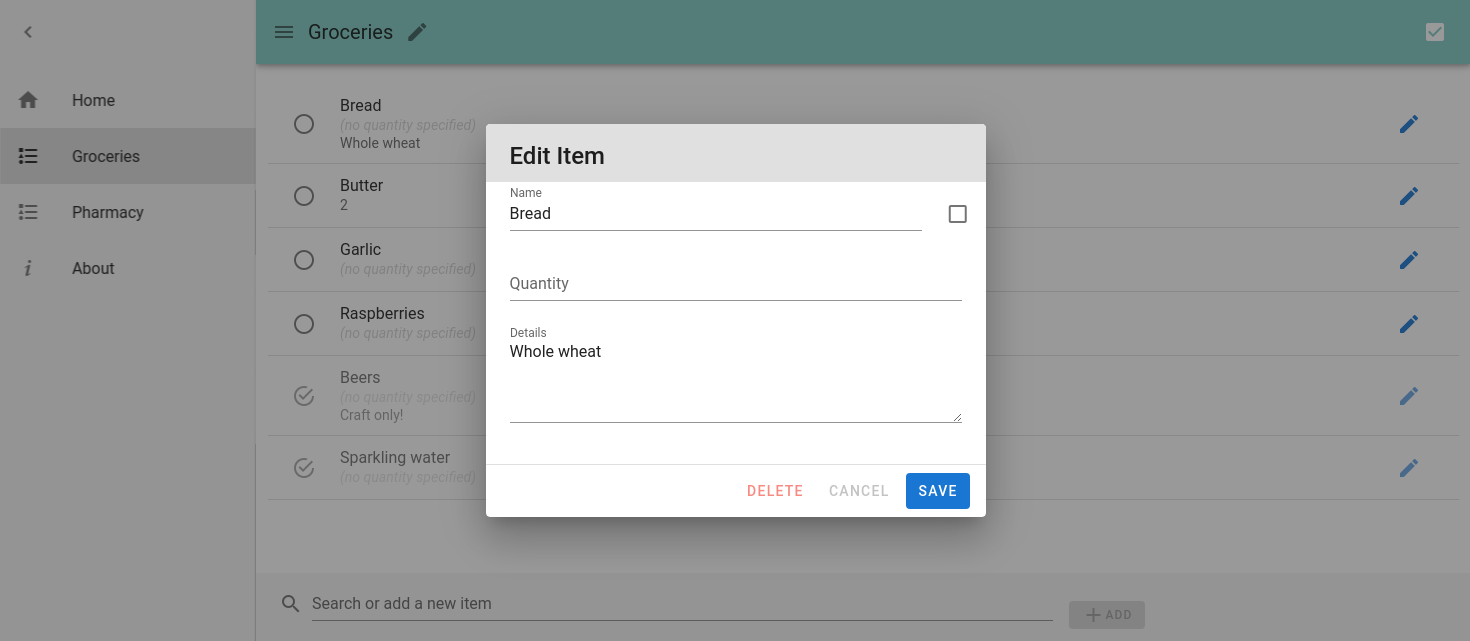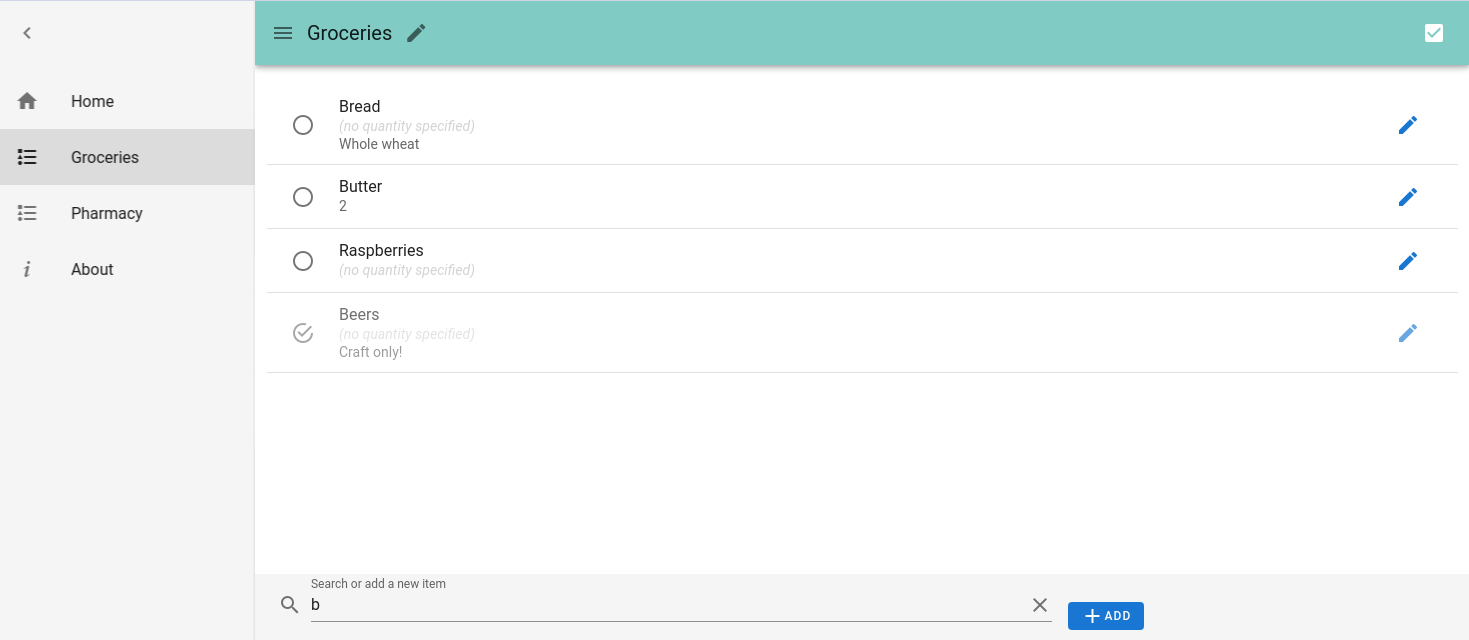
OSL is a simple shared list application. Typical uses include shopping lists of course, and any other small todo-list that needs to be used collaboratively.
The current implementation provides the following features:
- Multiple boards (can be disabled, see
VUE_APP_SINGLEBOARD_MODE) - Each board with multiple lists
- Real-time sync between users
- Items with the following fields: name, quantity, details
- Checkable items
- 2 display modes for items (unchecked only / checked only, sorted by check time)
- Intuitive search
- Mobile-first UI with swipeable items
- PWA basic support
- Partial internationalisation (i18n)
- Only EN and FR languages are available at that time, but PR are welcome for more! See examples here.
But, at this date it lacks the following:
- Full PWA support with offline mode and deferred sync
Before v2, all of the lists on an instance were available to all users.
Version 2 introduces a new feature called "boards". It's simply a way to group lists together under a common name. That name can then be shared so that people use the lists from a board collaboratively.
But, you might want to disable that feature and keep using a unique board for
your whole instance. In that case, just use the provided
VUE_APP_SINGLEBOARD_MODE environment variable.
But have no fear, you can always:
- Switch from singleboard mode to multi-board
- In that case you'll have to create a new board and choose it as target for existing lists with the provided CLI tool.
- Switch from multi-board mode to singleboard
- In that case you can choose which lists to migrate to the special unique board, but you'll lose access to all other lists (they are not deleted, just not accessible anymore)
See next § for instructions on how to enable one mode or the other.
Version 2 has added the multiboard feature which changes the default mode the application runs into.
If you already had a working v1, and would like to upgrade to v2 please follow the steps below:
⚠ Back up your data before proceeding!
- Make sure you set the
VUE_APP_SINGLEBOARD_MODEto1 - Once started, use the CLI to migrate existing lists to the special board
used as common parent for lists in "singleboard" mode.
docker compose exec app node cli.js board:create --singleboard docker compose exec app node cli.js list:move-to-board --all --singleboard
- Use the application as usual (you might have to clear your browser's cache to make sure there's no invalid data left).
- Make sure
VUE_APP_SINGLEBOARD_MODEis not set or set to0 - Create a new board with the name of your choice
# Get the created board's slug from the output and use it in the following command docker compose exec app node cli.js board:create my-board docker compose exec app node cli.js list:move-to-board --all --board my-board
- Open the application, and from the home screen open the board you've just created to find your lists.
☝ Screenshots are from v1, but v2 looks mostly the same.
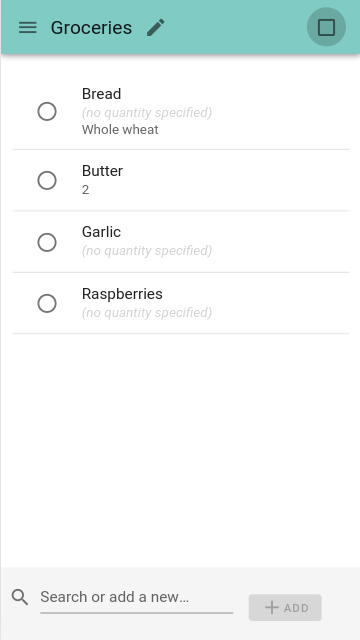
☝ Screenshots are from v1, but v2 looks mostly the same.
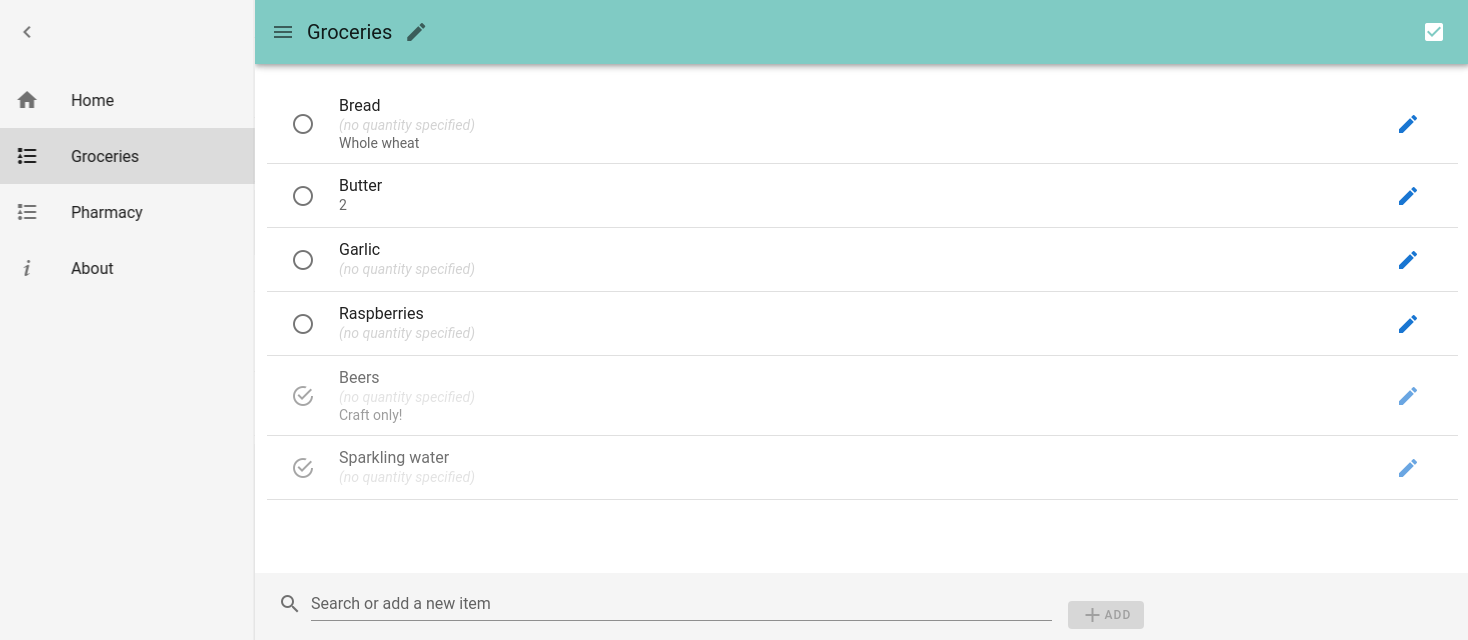
With a running MongoDB container as
mymongo on the host:
docker run --detach \
--name our-shopping-list \
--link mymongo:mongodb \
--publish 80:8080 \
ourshoppinglist/our-shopping-listUse the provided docker-compose.yml and adapt it to
your needs.
Then to start the containers:
docker compose up -dAvailable environment variables for the app container
-
System keys
LISTEN_PORT(default:8080)MONGODB_HOST(default:mongodb)MONGODB_PORT(default:27017)MONGODB_DB(default:osl)BASE_URL(default: empty) Set to base path if your web root is not/(ex:/my-osl/)
MongoDB authentication is not supported yet.
-
Application keys
VUE_APP_APM_ENABLED(default:0) ReferenceVUE_APP_APM_LOGLEVEL(default:warn) ReferenceVUE_APP_APM_SERVERURL(default:http://localhost:8200) ReferenceVUE_APP_APM_SERVERURLPREFIX(default:/intake/v${apiVersion}/rum/events) ReferenceVUE_APP_APM_SERVICENAMEReferenceVUE_APP_BOARD_DELETION_ENABLED(default:0) ReferenceVUE_APP_CHECKED_ITEMS_HISTORY_SORT_FIELD(default:lastCheckedAt, see available fields here)VUE_APP_CHECKED_ITEMS_HISTORY_SORT_ORDER(default:desc)VUE_APP_CLIENT_LOG_CONSOLE_ENABLED(default:false, see doc here)VUE_APP_CLIENT_LOG_ENABLED(default:false, see doc here)VUE_APP_CLIENT_LOG_LEVEL(default:debug)VUE_APP_EDIT_ITEM_ON_CREATE(default:0)VUE_APP_HOME_MESSAGE(default: empty)VUE_APP_I18N_FALLBACK_LOCALE(default:en)VUE_APP_I18N_FORCE_LOCALE(default:0)VUE_APP_I18N_LOCALE(default:en)VUE_APP_LIST_ALL_BOARDS_ENABLED(default:0, has no effect in singleboard mode)VUE_APP_LOCALSTORAGE_KEY_PREFIX(default:OurShoppingList_)VUE_APP_SHORT_TITLE(default:OSL)VUE_APP_SINGLEBOARD_MODE(default:0)VUE_APP_SOCKETIO_CSR_MAXDISCONNECTIONDURATION(default:1800000= 30mn)VUE_APP_SOCKETIO_PING_INTERVAL(default:25000= 25sec.)VUE_APP_SOCKETIO_PING_TIMEOUT(default:20000= 20sec.)VUE_APP_TITLE(default:Our Shopping List)VUE_APP_USE_ITEM_QUICK_SYNTAX(default:0) Reference
By default, the embedded robots.txt prevents search engines from browsing the application:
User-agent: *
Disallow: /
You can change this behavior by mounting the robots.txt of your choice at /app/robots.txt in the container.
OSL uses a WebSocket to allow server-to-client communication. So using a reverse-proxy to forward the connection implies the presence of the following sections below in the corresponding virtual host.
Replace 127.0.0.1 and 8080 with the IP of the OSL host if your RP is not
the host itself and/or if you're using another port.
<Proxy *>
Allow from all
</Proxy>
ProxyPass / http://127.0.0.1:8080/
ProxyPassReverse / http://127.0.0.1:8080/
ProxyPreserveHost On
RewriteEngine On
RewriteCond %{HTTP:Upgrade} =websocket [NC]
RewriteRule /(.*) ws://127.0.0.1:8080/$1 [P,L]
RewriteCond %{HTTP:Upgrade} !=websocket [NC]
RewriteRule /(.*) http://127.0.0.1:8080/$1 [P,L]
location / {
proxy_set_header Host $host;
proxy_set_header X-Real-IP $remote_addr;
proxy_set_header X-Forwarded-For $proxy_add_x_forwarded_for;
proxy_set_header X-Forwarded-Proto $scheme;
proxy_pass http://localhost:8080;
proxy_http_version 1.1;
proxy_set_header Upgrade $http_upgrade;
proxy_set_header Connection "Upgrade";
proxy_redirect http://localhost:8080 https://ourshoppinglist.myhost;
}
Remember to set the BASE_URL variable to the matching web root on each instance.
Make sure you set VUE_APP_LOCALSTORAGE_KEY_PREFIX to a unique value too, otherwise clients switching from
one instance to another might corrupt the internal cache in their browser.
Example:
- 1st instance on https://my.host/public-osl
BASE_URL=public-osl/VUE_APP_LOCALSTORAGE_KEY_PREFIX=OSL1_
- 2nd instance on https://my.host/private-osl
BASE_URL=private-osl/VUE_APP_LOCALSTORAGE_KEY_PREFIX=OSL2_
- etc.
You can use the standard DEBUG
environment variable to enable the verbose mode of the server:
Example to log all operations related to socket-io (WebSocket) and the URL rewrite process
(when using a custom BASE_URL):
DEBUG=socket.io:server,express-urlrewrite
Or if you need to log everything:
DEBUG=*
From the original release until june 2024, the stack was shipped with mongo:4 but this version
of MongoDB is deprecated and you can safely upgrade to MongoDB 7 while keeping your existing data.
Use the provided automated script as follows:
# Make a backup with mongodump first!
docker compose exec -T mongodb mongodump -d osl --archive > osl-backup.archive
bash doc/update-mongo7.sh🐋 This method also uses Docker, but with the local source files mounted into the
nodecontainer.
First of all, clone this project in the directory of your choice. Then from it:
make dev-pull
make dev-init
make dev-updNow start the Webpack Development Server with
make dev-watchIf you don't, you'll get 504 errors in the console on
/sockjs-node/*requests and you won't get hot reloading on changes.
If you want to enter the container, just use
make dev-shellTranslations can be very easily added and improved using the files from the client/src/locales/
directory.
If you want to translate OSL in a new language, feel free to add your contribution using
Weblate.
Register on Weblate and go to https://hosted.weblate.org/projects/our-shopping-list/client-src-locales/
In development mode, the service worker is not enabled. To workaround this limitation, you may want to ponctually build the JS bundle in "production" mode.
Here's how:
make dev-shell
cd client/
NODE_ENV=production yarn buildThen reload the page in your browser and the SW should be activated.
You have to make sure you are running the app with TLS enabled. Use the
ENABLE_TLS variable to use the embedded TLS proxy if needed.
Use the provided automated script as follows:
export COMPOSE_FILE=docker-compose.dev.yml
export DOCKER_COMPOSE_FILE=docker-compose.dev.yml
bash doc/update-mongo7.sh